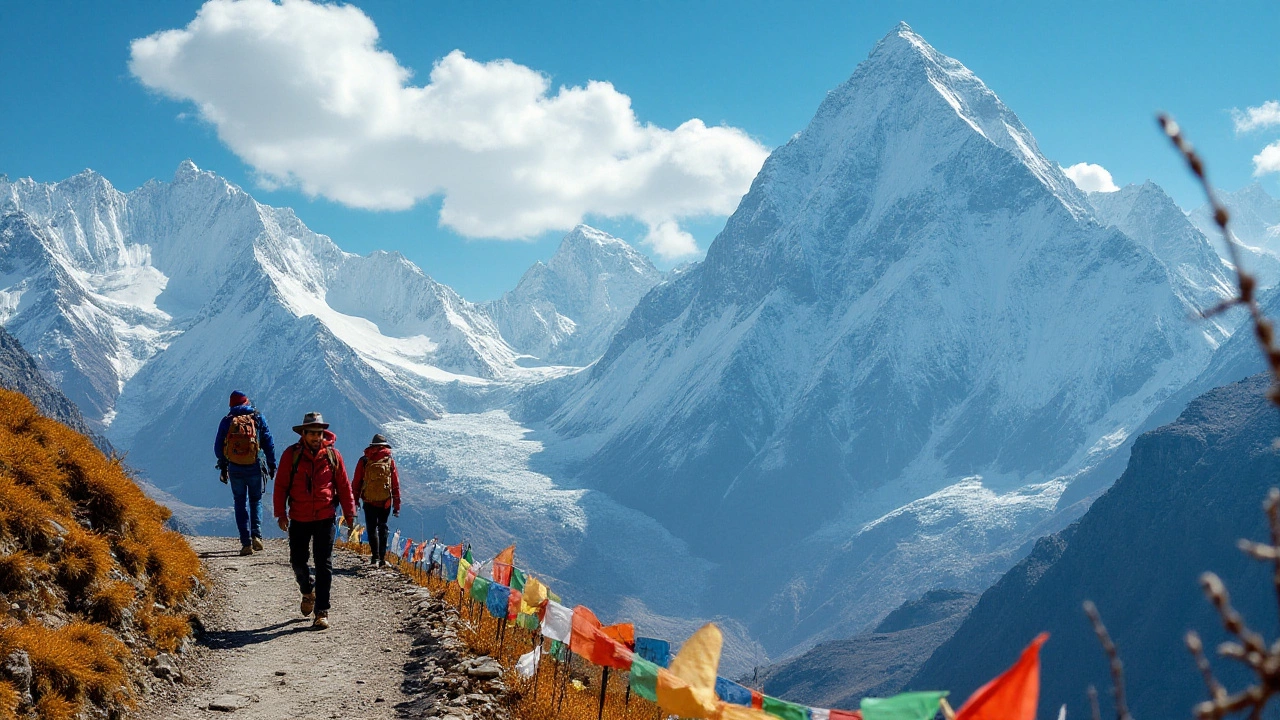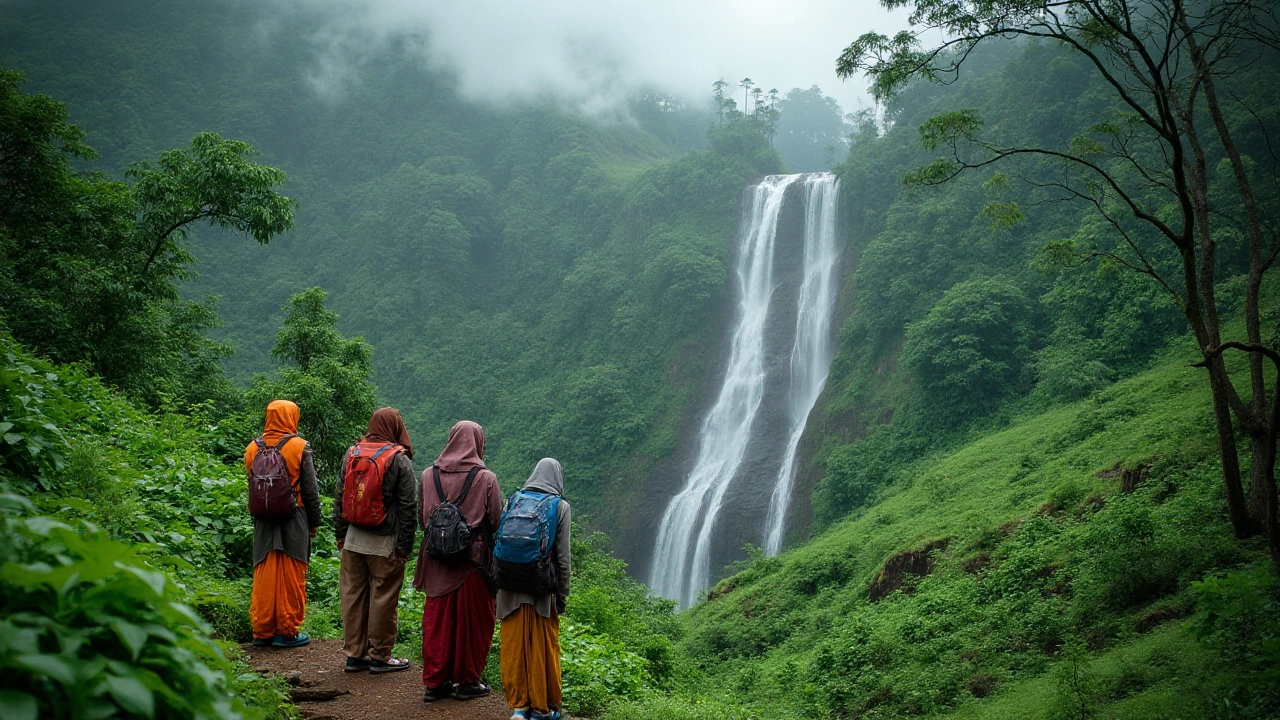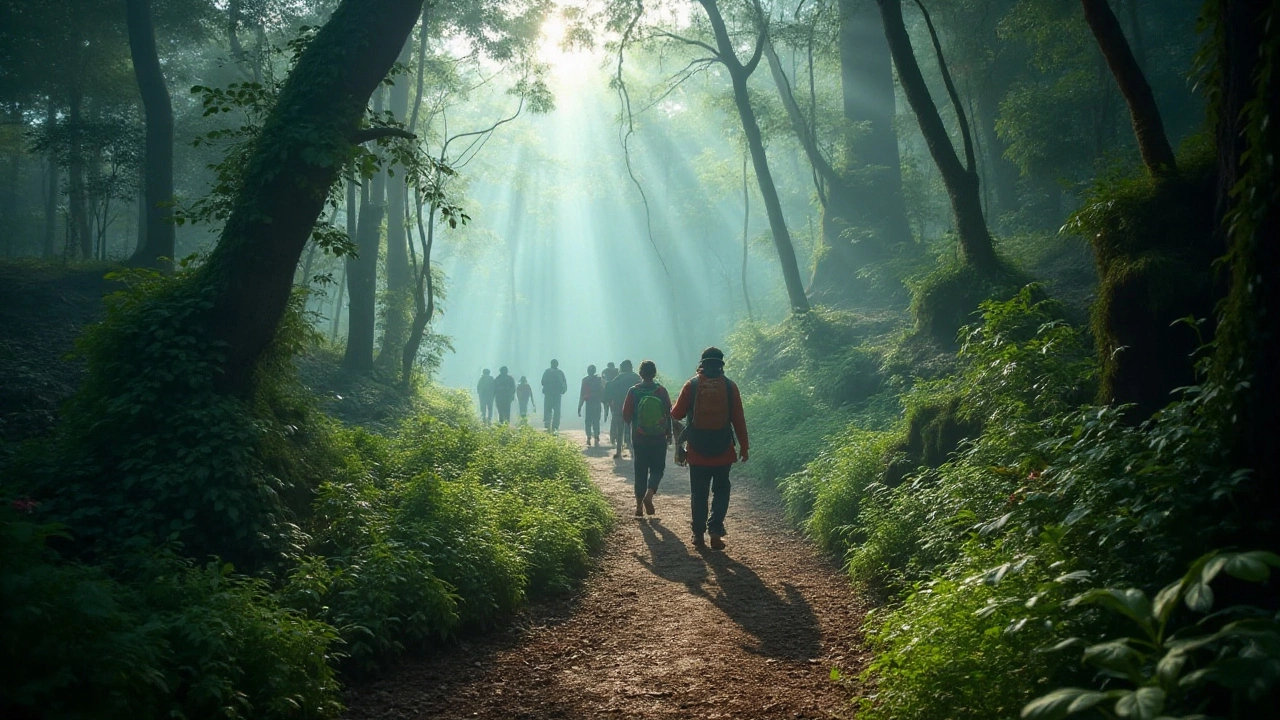SEARCH
Top State for Hiking in India: A Trekking Enthusiast's Guide


India is a land of extraordinary contrasts, especially when it comes to hiking. From the soaring peaks of the Himalayas to the serene paths of the Western Ghats, the country offers a treasure trove of trekking opportunities. For many adventurers, pinpointing the best state for hiking is no small feat. It requires navigating through dozens of breathtaking trails, each with unique challenges and rewards.
Whether you're a seasoned trekker or a newbie eager to catch the hiking bug, diving into the multitude of options across India is both thrilling and occasionally overwhelming. Today, we embark on a journey to explore which state holds the crown for the best hiking experiences, giving you insights into trails adored by hiking aficionados and secret paths glorified by locals. Buckle up as we traverse through India’s most revered hiking destinations.
- The Diversity of Indian Trekking Routes
- Why Sikkim Stands Out
- Trekking Trails of Uttarakhand
- Hidden Gems in Himachal Pradesh
- Tips for First-Time Hikers in India
The Diversity of Indian Trekking Routes
The rich tapestry of India's geographical spread presents a delightful platter for hiking in India, tempting adventurers with its kaleidoscope of trails varying in difficulty, terrain, and cultural exposure. The Indian subcontinent is blessed with the mighty Himalayas to the north, offering routes that challenge even the most seasoned mountaineers. Some trails, like the legendary Chadar Trek in Ladakh, demand trekkers to walk on a frozen river, truly testing both endurance and bravery each winter. Contrasting these alpine giants, the lush Sahyadris of the Western Ghats unfold a different story altogether. With their verdant landscapes and rich biodiversity, trekking here is equally about enjoying a green escapade as it is about conquering peaks.
Diversity is the essence of Indian trekking routes; they are as much about cultural immersion as they are about physical challenge. The treks through Zanskar or the Spiti Valley unfold hidden Buddhist monasteries and ancient villages that appear untouched by time. Trekking through these terrains is more than just an adventure sport; it's a passage through history and culture. Meanwhile, South India offers hiking experiences that weave through dense jungles, revealing the unique wildlife found in places like the Nilgiris Biosphere Reserve. This diversity not only enriches a trekker's journey but also encapsulates the vibrant essence of the Indian landscape, from the snow-kissed mountains to the dense tropical forests of Kerala and Tamil Nadu.
Trekking destinations in states like Uttarakhand, Himachal Pradesh, Sikkim, and Arunachal Pradesh introduce hikers to the mesmerizing variety of indigenous flora and fauna. In these states, trails such as the Roopkund Trek in Uttarakhand reveal enchanting vistas with a mysterious lake lined with ancient human skeletons. These peculiarities draw the curious and the adventurous alike, promising stories and views unlike any other. The remote trails of Meghalaya, known for its living root bridges, offer an ecological wonder, showcasing the ingenuity and harmony of tribal life with nature. A journey along these routes is a journey into the heart of India's natural wonder.
The diversity doesn't end with the landscapes and experiences; it extends to the seasons too. Summers invite explorers to escape the heat and flock to the cooler climes of Himalayan treks, whereas monsoon treks in the Western Ghats surge to life with the season's first rains, transforming the vistas into lush green canvases. Each season offers a different perspective, ensuring that trekking in India never feels repetitive. As the renowned mountaineer Sir Edmund Hillary once said,
"It is not the mountain we conquer, but ourselves."His words resonate with every trekker in India, each path, be it rocky or gentle, opens doors to self-discovery amid the unpredictable yet beautiful Indian terrains.
Why Sikkim Stands Out
Nestled in the embrace of the majestic Himalayas, the northeastern state of Sikkim is a paradise for those with a penchant for nature and adventure. It's not just the scenic beauty that draws trekkers from far and wide but also the unique blend of culture, biodiversity, and challenging trails that make Sikkim a premier hiking hotspot in India. With its strategic location, bordered by Bhutan, Tibet, and Nepal, Sikkim is blessed with a varied landscape that presents hikers with verdant forests, alpine meadows, and the awe-inspiring backdrop of the Khangchendzonga, the third-highest mountain in the world. The state's hiking scene is as diverse as its landscape, offering trails suitable for both budding adventurers and experienced trekkers.
One of the most talked-about treks is the Goechala Trek. This trail is a vibrant tapestry of experiences, starting in the lush greenery of Yuksom and ascending through dense forests, across glacial moraine, and up to the spectacular viewpoints of Dzongri and Goechala where trekkers are rewarded with unparalleled views of Mount Khangchendzonga. The cultural richness of Sikkim also adds to its charm as a hiking destination. Trails are often lined with Buddhist monasteries, prayer flags flapping in the mountain winds, and small, welcoming villages where the locals greet hikers with warm hospitality. This cultural attachment to the land is deeply ingrained in the trail experiences, making each step an exploration of not just the natural world but also the spiritual connections of the region.
The biodiversity of Sikkim is another reason it stands out as an exceptional trekking state. Hikers may encounter exotic flora and fauna, from the rare red panda to the colorful rhododendrons that paint the hillsides in spring. The state's environmental preservation efforts mean that these treasures are protected, giving visitors a chance to witness these miracles in a clean and untouched setting. According to the Sikkim Forest Department, the region is home to over 4,500 species of flowering plants and numerous endangered species, emphasizing the critical role the state plays in conservation. For those appreciative of nature's untouched beauty, Sikkim delivers unparalleled satisfaction.
"Sikkim is an ideal destination for those who wish to experience the Himalayas while treading lightly on the earth," notes renowned conservationist A. K. Ganguly.
The best time for hiking in India, particularly in Sikkim, is considered to be from March to May or September to November. During these months, the trails are accessible, the weather is favorable, and the vibrant rhododendrons are in bloom. Preparing for a trek in Sikkim involves thoughtful planning, as the trails, though breathtaking, can be demanding. It's advisable for trekkers to acclimatize properly, stay hydrated, and respect the local customs and environmental guidelines to ensure their journey is both safe and respectful of the pristine landscapes they are privileged to traverse.

Trekking Trails of Uttarakhand
Uttarakhand, nestled in the heart of the Himalayas, is a hiker's paradise boasting diverse and thrilling trails that attract adventurers from around the globe. Known as the 'Land of the Gods', this state offers an incredible range of breathtaking landscapes - from snow-clad peaks to verdant valleys and dense forests. Here, each trail has its unique appeal, making it one of the best regions for trekking in India. The spiritual aura of the place adds a mystical touch to the trekking experience, which can be both exhilarating and profound.
One of the most famous trekking routes in Uttarakhand is the Valley of Flowers trek. This UNESCO World Heritage site is a riot of colors and fragrances from the myriad wildflowers that bloom during the monsoon. As you venture through this vibrant valley, you'll be mesmerized by the exotic flora and stunning vistas. Another must-explore trail is the Kedarkantha trek, perfect for winter trekking enthusiasts. Known for its stunning snow-covered landscapes and star-studded night skies, it offers a serene adventure for those who dare to embrace the winter chill.
The Roopkund trek is another gem that beckons trail lovers with its mysterious stories woven around the glacial lake known for human skeletal remains. This trek is as much a journey into the history and mystery as it is an exploration of nature's beauty, providing a unique blend of thrill and fascination. For those seeking a trek with a spiritual element, the Hemkund Sahib trek is worth considering. This pilgrimage trail not only takes you to the revered Sikh shrine but also overlooks the pristine Hemkund lake surrounded by snow-laden peaks.
According to a report by the Uttarakhand Tourism Development Board, the state has seen a 25% increase in trekking enthusiasts over the past year, highlighting its rising popularity among global hikers.
Hiking in India wouldn't be complete without a mention of the thrilling Panch Kedar trek. This path is a spiritual journey through the five sacred temples devoted to Lord Shiva, each nestled amidst awe-inspiring mountain scenery and tranquil settings. Trekkers are often left speechless by the majestic views of the Himalayas as they experience the profound peace of these spiritual sites. Adventures in Uttarakhand are not only about physical challenges but also about connecting deeply with oneself and the nature that envelopes you.
For those embarking on their first trek here, the Chopta Tungnath Chandrashila trek is a good starting point. Known for its moderate difficulty and rewarding views, it combines an impressive array of landscapes. Trekkers are treated to panoramic views of majestic Himalayan peaks from the summit of Chandrashila, especially during sunrise when the mountains glow with a golden hue. These experiences are why so many adventurers consider Uttarakhand the pinnacle of trekking destinations in India, offering an array of routes that cater to everyone from beginners to seasoned hikers.
Hidden Gems in Himachal Pradesh
When most people think of trekking in Himachal Pradesh, famous names like Manali and Dharamshala often come to mind. However, this state offers a vast array of lesser-known trails that promise equally, if not more, magical experiences. Tucked away from the more frequented paths, these treks present a unique blend of nature, adventure, and raw beauty that attracts those in search of something different.
One such hidden treasure is the Hampta Pass trek, linking the lush valleys of Kullu with the stark desert landscapes of Lahaul. This trail provides an unforgettable experience as you transition from green meadows to barren mountain views over just a few days. The gradual ascent makes it perfect for beginners, offering a taste of diverse terrains without the daunting heights of more difficult hikes. Along the route, trekkers will encounter scenic spots like the glacial Chandra Tal Lake, where reflections of snow-capped peaks create picture-perfect moments.
An equally enchanting yet lesser-known route is the Buran Ghati trek. Starting in the quaint village of Janglik, this journey winds through a vibrant tapestry of flower-blanketed meadows, dense forests, and ancient villages that seem untouched by modernity. The trek boasts challenging sections — particularly the thrilling snow descent from Buran Pass — however, it's the scenic payoff and cultural interactions that make it unforgettable. Conversations with shepherds and villagers along the way offer insights into the simple, yet rich lives led here.
According to well-loved adventurer and writer, Bill Aitken, "Himachal's less trodden paths reveal not just the sublime beauty of nature, but the spirit of its people." His words ring true, especially for the Chandrakhani Pass trek, a route steeped in mythology and beauty. This path takes you through densely wooded forests and ridge-top walks with panoramic views that feel like nature’s amphitheater playing out its most dramatic scenes.
For those seeking hidden trails, the Great Himalayan National Park offers a range of opportunities to dive into biodiversity and pristine landscapes. Declared a UNESCO World Heritage site, the park is home to well-preserved ecosystems, rare plant species, and elusive wildlife. Trekking here isn't just about the journey, it's about immersing in and respecting a part of untouched natural world that many don’t get to experience. With its meandering paths and unspoiled beauty, it attracts nature lovers and thrill-seekers alike, yet still remains one of Himachal's best-kept secrets.
These hidden gems, while off the beaten path, provide the allure of discovery and the thrill of the unknown. As more hikers uncover these trails, it’s the tales of personal encounters and the striking beauty that continue to establish Himachal Pradesh as a strong contender for India's best trekking destinations. Whether you're drawn to challenging climbs, serene landscapes, or cultural dives, these lesser-known routes promise to deliver memories that last a lifetime.

Tips for First-Time Hikers in India
Embarking on your first hiking adventure in India can be an exhilarating experience, but it requires some preparation to ensure a successful journey. The diverse landscapes, ranging from the Himalayan mountains to the beaches of Goa and breathtaking regions like Ladakh, offer a range of challenges for beginners. Preparation starts with choosing the right trail that is suitable for your fitness level. For those new to trekking, opting for routes in Uttarakhand or the lush green trails of Sikkim can be an excellent choice as they offer manageable elevations and wonderful vistas without overwhelming difficulty.
Before setting off on your trek, it's vital to equip yourself with the necessities. A sturdy pair of hiking boots is indispensable for tackling uneven terrain, coupled with layers of clothing to adjust to India's ever-changing climates. Valuing comfort over style cannot be stressed enough; you will appreciate those extra comfortable clothes when you hit steep ascents or rocky paths. Equip your backpack with plenty of water, energy snacks, and a reliable map—even in this digital age, online maps may fail where offline paper ones shine.
A worthwhile tip is to stay informed about the weather conditions of your chosen location. India’s weather can be unpredictable, especially in the mountains where sudden rain showers or fog can obscure the trail. Travelling during the dry months is generally advisable, as it reduces the risks associated with slippery trails and landslides. This is particularly true in monsoon-sensitive areas like the Western Ghats, where hiking should be cautiously avoided during the wet seasons. Seek advice from local guides who possess an intimate knowledge of the trails, able to guide you safely and share insightful information about the flora and fauna.
Connect with fellow hikers and travel communities online. These groups can offer you indispensable insights and first-hand tips from trekkers who have experienced the trails themselves. They can advise on everything from potential hazards to hidden gems worth exploring. If you have a chance, join a group trek; the camaraderie and collective knowledge can enrich the experience, and being part of a group offers additional safety, especially in remote areas.
Remembering the Leave No Trace principles is crucial. Keep India’s hiking routes pristine by ensuring you leave nothing behind. Carry out all trash, avoid picking plants, and respect wildlife. Trekkers are the custodians of nature, and adopting a sustainable mindset not only preserves the environment but leaves a clean trail for others to enjoy. Keeping local wildlife safe and paths clean should be a part of every hiker's ethic. In some regions, local regulations may require hiring a certified guide or obtaining permits, so always check these requirements to ensure compliance and support protected areas.
The Indian Mountaineering Foundation states, "With every trek, the trail stories should inspire and educate, making each outing more than just a journey but a path of learning."Engaging with local customs and culture while respecting them enhances the profound beauty of trekking in India. Treks are often pathways through village life, and respectful interaction can lead to enriching experiences and stories shared.
For first-time hikers, these practical tips not only enhance the experience but ensure safety and enjoyment, allowing you to soak in the beauty of India's vast landscape without unnecessary worry. With preparation and an open mind, your first trek can carve unforgettable memories and serve as a launching pad for future adventures.